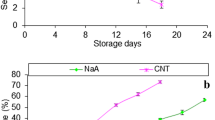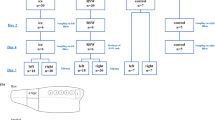Abstract
Effective cooling of newly caught fish is of great importance to inhibit bacterial growth and therefore increase quality, safety and shelf life of the product. In this study, two commercial cooling media (liquid ice A and B) were tested and their performance was compared to conventional plate ice during chilled 8-day storage of whole, gutted haddock. Temperature was monitored, and deteriorative changes were followed by conventional microbiological counts [(total viable psychrotrophic; specific spoilage organisms and physicochemical methods (pH, TVB-N, TMA, salt content)]. A cultivation-independent method (16S rRNA clone analysis) was used to study the effect of cooling treatments on the bacterial community of haddock initially and at the end of storage. The results show that the bacterial growth behaviour observed for differently cooled fish was not supported by their temperature profiles. Growth of the SSOs, Photobacterium phosphoreum and H2S-producing bacteria was delayed at early storage, independently of the cooling methods. With further storage, little or no count differences were seen among traditionally iced fish and those cooled in liquid ice with a top ice layer. At the end of storage, significant (p < 0.05) increase in P. phosphoreum and H2S-producing bacteria counts of skin and flesh sampled from liquid ice with no top ice layer was observed along with higher salt, TVB-N and TMA flesh content. Cultivation-independent analysis confirmed the dominance of P. phosphoreum in fish stored in liquid ice B with no top layer (up to 76% dominance) and liquid ice A with top layer (44% dominance). Psychrobacter and Flavobacterium dominated the microbiota of fish stored in conventional plate ice and liquid ice B with ice top layer. The study shows that the use of liquid ice prepared from brine provides faster initial cooling of whole fish but may create unfavourable conditions under extended storage where the active spoiler P. phosphoreum becomes dominant. Plate ice may therefore be an optimal medium for extended fish storage.





Similar content being viewed by others
References
Olafsdottir G, Lauzon HL, Martinsdottir E, Oehlenschlager J, Kristbergsson K (2006) Evaluation of shelf-life of superchilled cod (Gadus morhua) fillets and influence of temperature fluctuations on microbial and chemical quality indicators. J Food Sci 71:97–109
Sivertsvik M, Jeksrud WK, Rosnes JT (2002) A review of modified atmosphere packaging of fish and fishery products—significance of microbial growth, activities and safety. Int J Food Sci Technol 37:107–127
Wang T, Sveinsdottir K, Magnusson H, Martinsdottir E (2008) Combined application of modified atmosphere packaging and superchilled storage to extend the shelf life of fresh cod (Gadus morhua) loins. J Food Sci 73:S11–S19
Lauzon HL, Magnusson H, Sveinsdottir K, Gudjonsdottir M, Martinsdottir E (2009) Effect of brining, modified atmosphere packaging, and superchilling on the shelf life of cod (Gadus morhua) loins. J Food Sci 74:M258–M267
Laycock RA, Regier LW (1970) Pseudomonads and Achromobacters in the spoilage of irradiated haddock of different preirradiation quality. Appl Microbiol 20:333–341
Dalgaard P (1995) Qualitative and quantitative characterization of spoilage bacteria from packed fish. Int J Food Microbiol 26:319–333
Gram L, Trolle G, Huss HH (1987) Detection of specific spoilage bacteria from fish stored at low (0°C) and high (20°C) temperatures. Int J Food Microbiol 4:65–72
Bellas I, Tassou SA (2005) Present and future applications of ice slurries. Int J Refrig 28:115–121
Egolf PW, Kauffeld M, Kawaij M (2005) Handbook on ice slurries—fundamentals and engineering. International Institute of Refrigeration, Paris, pp 259–263
Gram L, Huss HH (1996) Microbiological spoilage of fish and fish products. Int J Food Microbiol 33:121–137
McMeekin TA (1975) Spoilage association of chicken breast muscle. Appl Microbiol 29:44–47
von Holy A, Holzapfel WH (1988) The influence of extrinsic factors on the microbiological spoilage pattern of ground beef. Int J Food Microbiol 6:269–280
Dalgaard P, Mejlholm O, Christiansen TJ, Huss HH (1997) Importance of Photobacterium phosphoreum in relation to spoilage of modified atmosphere-packed fish products. Lett Appl Microbiol 24:373–378
Emborg J, Laursen BG, Rathjen T, Dalgaard P (2002) Microbial spoilage and formation of biogenic amines in fresh and thawed modified atmosphere-packed salmon (Salmo salar) at 2 degrees C. J Appl Microbiol 92:790–799
Van Spreekens KJA (1974) The suitability of Long and Hammer’s medium for the enumeration of more fastidious bacteria from fresh fishery products. Arch Lebensm 25:213–219
Esaiassen M, Nilsen H, Joensen S, Skjerdal T, Carlehog M, Eilertsen G, Gundersen B, Elvevoll E (2004) Effects of catching methods on quality changes during storage of cod (Gadus morhua). Lebensm Wiss Technol 37:643–648
Olafsdottir G, Lauzon HL, Martinsdottir E, Kristbergsson K (2006) Influence of storage temperature on microbial spoilage characteristics of haddock fillets (Melanogrammus aeglefinus) evaluated by multivariate quality prediction. Int J Food Microbiol 111:112–125
Biers EJ, Sun S, Howard EC (2009) Prokaryotic genomes and diversity in the surface ocean: interrogating the global ocean sampling metagenome. Appl Environ Microbiol 75:2221–2229. doi:10.1128/AEM.02118-08
DeLong EF (2005) Microbial community genomics in the ocean. Nat Rev Microbiol 3:459–469
Stanbridge LH, Board RG (1994) A modification of the Pseudomonas selective medium, CFC, that allows differentiation between meat pseudomonads and Enterobacteriaceae. Lett Appl Microbiol 18:327–328
Dalgaard P, Mejlholm O, Huss HH (1996) Conductance method for quantitative determination of Photobacterium phosphoreum in fish products. J Appl Bacteriol 81:57–64
Reynisson E, Lauzon HL, Magnusson H, Hreggvidsson GO, Marteinsson VT (2008) Rapid quantitative monitoring method for the fish spoilage bacteria Pseudomonas. J Environ Monit 10:1357–1362
Marteinsson VT, Hauksdottir S, Hobel CF, Kristmannsdottir H, Hreggvidsson GO, Kristjansson JK (2001) Phylogenetic diversity analysis of subterranean hot springs in Iceland. Appl Environ Microbiol 67:4242–4248
Reynisson E, Lauzon HL, Magnusson H, Jonsdottir R, Olafsdottir G, Marteinsson VT, Hreggvidsson GO (2009) Bacterial composition and succession during storage of North-Atlantic cod (Gadus morhua) at superchilled temperatures. BMC Microbiol 9:250
Aubourg SP, Losada V, Gallardo JM, Miranda JM, Velázquez JB (2006) On-board quality preservation of megrim (Lepidorhombus whiffiagonis) by a novel ozonised-slurry ice system. Eur Food Res Technol 223:232–237
Cakli S, Kilinc B, Dincer T, Tolasa S (2006) Effects of using slurry ice during transportation on the microbiological, chemical, and sensory assessments of aquacultured sea bass (Dicentrarchus labrax) stored at 4 degrees C. Crit Rev Food Sci Nutr 46:453–458
Pineiro C, Velázquez JB (2004) Effects of newer slurry ice systems on the quality of aquatic food products: a comparative review versus flake-ice chilling methods. Trends Food Sci Technol 15:575–582
Campos CA, Losada V, Rodrigues Ó, Aubourg SP, Velázquez JB (2006) Evaluation of an ozone–slurry ice combined refrigeration system for the storage of farmed turbot (Psetta maxima). Food Chem 97:223–230
Campos CA, Rodriguez O, Losada V, Aubourg SP, Barros-Velazquez J (2005) Effects of storage in ozonised slurry ice on the sensory and microbial quality of sardine (Sardina pilchardus). Int J Food Microbiol 103:121–130
Losada V, Pineiro C, Velázquez JB, Aubourg SP (2004) Inhibition of chemical changes related to freshness loss during storage of horse mackerel (Trachurus trachurus) in slurry ice. Food Chem 93:619–625
Hovda MB, Lunestad BT, Sivertsvik M, Rosnes JT (2007) Characterisation of the bacterial flora of modified atmosphere packaged farmed Atlantic cod (Gadus morhua) by PCR-DGGE of conserved 16S rRNA gene regions. Int J Food Microbiol 117:68–75
Author information
Authors and Affiliations
Corresponding author
Rights and permissions
About this article
Cite this article
Reynisson, E., Lauzon, H.L., Thorvaldsson, L. et al. Effects of different cooling techniques on bacterial succession and other spoilage indicators during storage of whole, gutted haddock (Melanogrammus aeglefinus). Eur Food Res Technol 231, 237–246 (2010). https://doi.org/10.1007/s00217-010-1273-z
Received:
Accepted:
Published:
Issue Date:
DOI: https://doi.org/10.1007/s00217-010-1273-z




